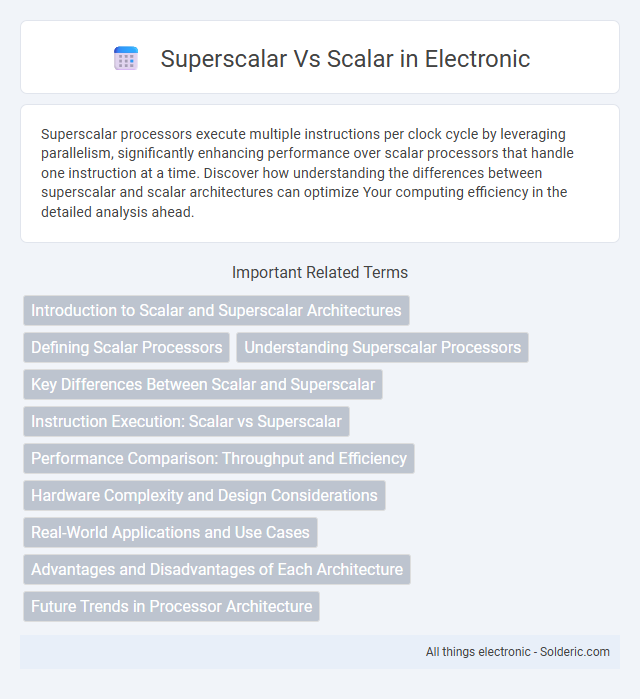Superscalar processors execute multiple instructions per clock cycle by leveraging parallelism, significantly enhancing performance over scalar processors that handle one instruction at a time. Discover how understanding the differences between superscalar and scalar architectures can optimize Your computing efficiency in the detailed analysis ahead.
Comparison Table
| Feature | Superscalar | Scalar |
|---|---|---|
| Definition | Executes multiple instructions per clock cycle using multiple execution units. | Executes one instruction per clock cycle sequentially. |
| Instruction Issue | Multiple instructions issued simultaneously. | One instruction issued at a time. |
| Performance | Higher throughput and improved performance due to parallelism. | Lower throughput, limited by single instruction per cycle. |
| Complexity | More complex hardware design, including multiple pipelines and scheduling logic. | Simpler hardware with a single pipeline. |
| Pipeline | Multiple execution pipelines handled in parallel. | Single pipeline handling instructions sequentially. |
| Use Case | High-performance processors in modern CPUs. | Basic processors or microcontrollers with simpler design needs. |
Introduction to Scalar and Superscalar Architectures
Scalar architectures process one instruction per clock cycle, executing a single operation sequentially, which limits throughput by relying on instruction-level parallelism within a simple pipeline. Superscalar architectures enhance performance by dispatching multiple instructions simultaneously to several functional units, leveraging parallel execution paths to increase instruction throughput. Understanding the distinction between scalar and superscalar designs allows you to optimize your system's processing efficiency based on workload characteristics and hardware capabilities.
Defining Scalar Processors
Scalar processors execute one instruction per clock cycle, processing a single data element at a time. They use a single instruction pipeline, leading to simpler design and predictable performance. Scalar architecture contrasts with superscalar processors, which issue multiple instructions simultaneously to enhance throughput.
Understanding Superscalar Processors
Superscalar processors execute multiple instructions per clock cycle by deploying several execution units, significantly enhancing CPU performance compared to scalar processors that handle one instruction at a time. The architecture of superscalar CPUs enables parallelism at the instruction level through out-of-order execution, dynamic scheduling, and advanced branch prediction techniques. This design reduces bottlenecks and increases throughput, making superscalar processors ideal for complex computing tasks requiring high processing power.
Key Differences Between Scalar and Superscalar
Scalar processors execute one instruction per clock cycle, handling a single data stream sequentially, which limits throughput. Superscalar processors can issue multiple instructions simultaneously by utilizing multiple execution units, significantly improving instruction-level parallelism and performance. Understanding these differences helps optimize Your system's architecture for specific computational workloads.
Instruction Execution: Scalar vs Superscalar
Scalar processors execute one instruction per clock cycle, processing instructions sequentially, which limits throughput and performance. Superscalar processors can issue multiple instructions simultaneously each cycle by utilizing multiple execution units, significantly increasing instruction-level parallelism. Your system's performance benefits from superscalar architecture when running complex applications that demand higher execution efficiency and speed.
Performance Comparison: Throughput and Efficiency
Superscalar architectures execute multiple instructions per clock cycle by dispatching them to multiple execution units, significantly increasing throughput compared to scalar processors that handle one instruction per cycle. The increased parallelism in superscalar designs improves overall efficiency by utilizing CPU resources more effectively and reducing idle execution units. However, superscalar processors require complex instruction scheduling and dependency checking, which may introduce overhead impacting performance gains in some workloads.
Hardware Complexity and Design Considerations
Superscalar processors increase hardware complexity by implementing multiple execution units and sophisticated instruction dispatch and scheduling logic to enable parallel instruction execution. Design considerations involve balancing pipeline depth, register file access, and branch prediction accuracy to optimize throughput without excessive power consumption or die area increase. Scalar processors maintain simpler hardware with a single instruction pipeline, reducing design effort and power use but limiting instruction-level parallelism and performance scalability.
Real-World Applications and Use Cases
Superscalar processors are widely used in high-performance computing environments such as gaming consoles, servers, and scientific simulations due to their ability to execute multiple instructions per clock cycle, enhancing throughput and application responsiveness. Scalar processors, with their simpler design, are often found in embedded systems, microcontrollers, and low-power devices where predictability and energy efficiency are critical. Your choice between superscalar and scalar architectures depends largely on the specific performance requirements and power constraints of the real-world application.
Advantages and Disadvantages of Each Architecture
Superscalar architecture executes multiple instructions per clock cycle, enhancing performance through parallelism but increasing complexity, power consumption, and potential pipeline hazards. Scalar architecture processes one instruction per cycle, offering simpler design, lower power use, and easier implementation but limiting throughput and efficiency in modern applications. Understanding these trade-offs helps you choose the optimal processor architecture for your performance and energy requirements.
Future Trends in Processor Architecture
Future trends in processor architecture emphasize the evolution from scalar to superscalar designs, enhancing parallel instruction execution to boost computing performance. Superscalar processors utilize multiple execution units, allowing Your system to process several instructions simultaneously, which is expected to integrate with advancements like out-of-order execution and speculative execution. Emerging technologies such as multi-core and heterogeneous computing architectures will further leverage superscalar principles to optimize efficiency and speed in next-generation CPUs.
Superscalar vs Scalar Infographic

 solderic.com
solderic.com